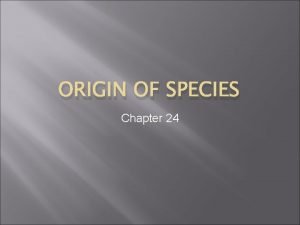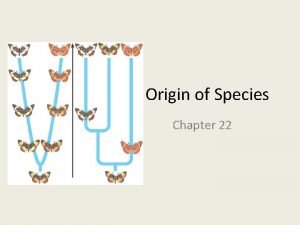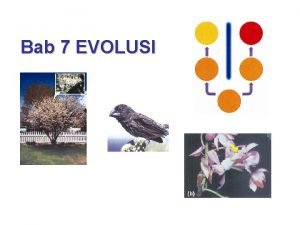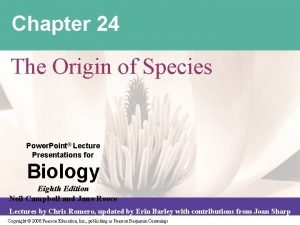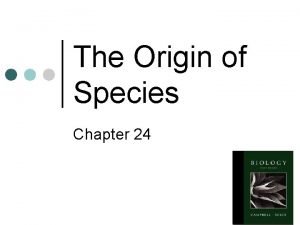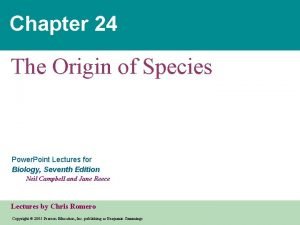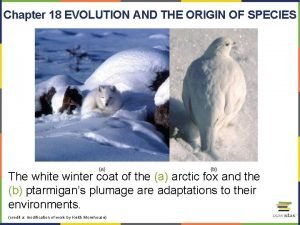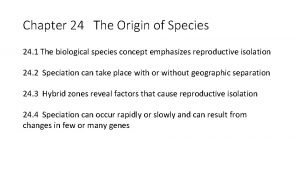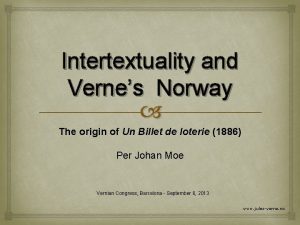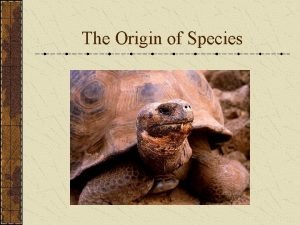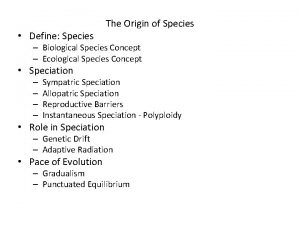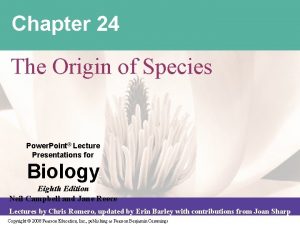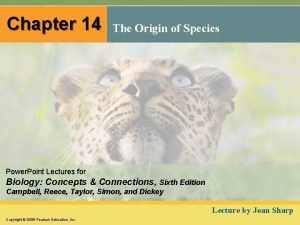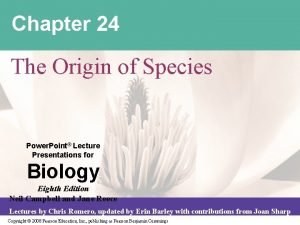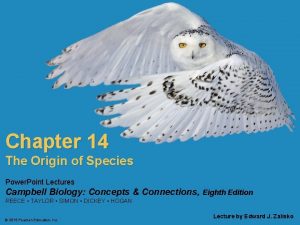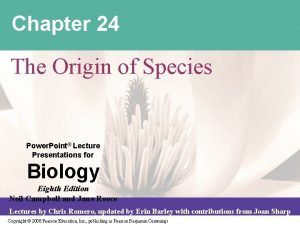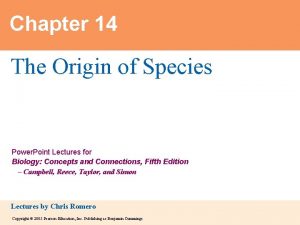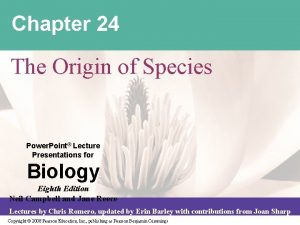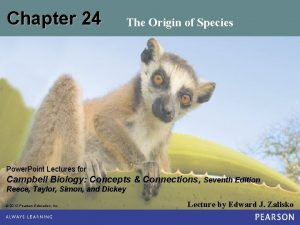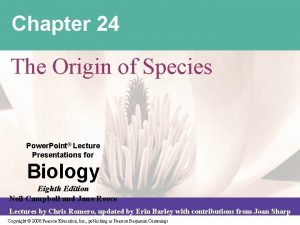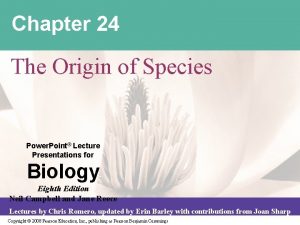Chapter 24 The Origin of Species Power Point




















- Slides: 20

Chapter 24 The Origin of Species Power. Point Lectures for Biology, Seventh Edition Neil Campbell and Jane Reece Lectures by Chris Romero Copyright © 2005 Pearson Education, Inc. publishing as Benjamin Cummings

• Speciation, the origin of new species, is at the focal point of evolutionary theory • Evolutionary theory must explain how new species originate and how populations evolve • Microevolution consists of adaptations that evolve within a population, confined to one gene pool • Macroevolution refers to evolutionary change above the species level Copyright © 2005 Pearson Education, Inc. publishing as Benjamin Cummings

Limitations of the Biological Species Concept • The biological species concept does not apply to – Asexual organisms – Fossils – Organisms about which little is known regarding their reproduction Copyright © 2005 Pearson Education, Inc. publishing as Benjamin Cummings

Other Definitions of Species • Morphological: defines a species by structural features • Paleontological: focuses on morphologically discrete species known only from the fossil record • Ecological: views a species in terms of its ecological niche • Phylogenetic: defines a species as a set of organisms with a unique genetic history Copyright © 2005 Pearson Education, Inc. publishing as Benjamin Cummings

Concept 24. 2: Speciation can take place with or without geographic separation • Speciation can occur in two ways: – Allopatric speciation – Sympatric speciation Copyright © 2005 Pearson Education, Inc. publishing as Benjamin Cummings

Allopatric (“Other Country”) Speciation • In allopatric speciation, gene flow is interrupted or reduced when a population is divided into geographically isolated subpopulations • One or both populations may undergo evolutionary change during the period of separation Copyright © 2005 Pearson Education, Inc. publishing as Benjamin Cummings

LE 24 -7 a Initial population of fruit flies (Drosophila pseudoobscura) Some flies raised on starch medium Mating experiments after several generations Some flies raised on maltose medium

LE 24 -7 b 22 9 8 20 Mating frequencies in experimental group Male Same Different populations population Male Maltose Starch Female Starch Maltose Female Different Same populations 18 15 12 15 Mating frequencies in control group

Sympatric (“Same Country”) Speciation • In sympatric speciation, speciation takes place in geographically overlapping populations Copyright © 2005 Pearson Education, Inc. publishing as Benjamin Cummings

Polyploidy • Polyploidy is presence of extra sets of chromosomes due to accidents during cell division • It has caused the evolution of some plant species • An autopolyploid is an individual with more than two chromosome sets, derived from one species Copyright © 2005 Pearson Education, Inc. publishing as Benjamin Cummings

LE 24 -8 Failure of cell division in a cell of a growing diploid plant after chromosome duplication gives rise to a tetraploid branch or other tissue. 2 n = 6 Gametes produced by flowers on this tetraploid branch are diploid. Offspring with tetraploid karyotypes may be viable and fertile— a new biological species. 2 n 4 n = 12 4 n

• An allopolyploid is a species with multiple sets of chromosomes derived from different species Copyright © 2005 Pearson Education, Inc. publishing as Benjamin Cummings

LE 24 -9 Unreduced gamete with 4 chromosomes Hybrid with 7 chromosomes Unreduced gamete with 7 chromosomes Viable fertile hybrid (allopolyploid) Meiotic error; Species A chromosome number not 2 n = 4 reduced from 2 n to n 2 n = 10 Normal gamete n=3 Species B 2 n = 6 Normal gamete n=3

Allopatric and Sympatric Speciation: A Summary • In allopatric speciation, a new species forms while geographically isolated from its parent population • In sympatric speciation, a reproductive barrier isolates a subset of a population without geographic separation from the parent species Copyright © 2005 Pearson Education, Inc. publishing as Benjamin Cummings

Adaptive Radiation • Adaptive radiation is the evolution of diversely adapted species from a common ancestor upon introduction to new environmental opportunities Copyright © 2005 Pearson Education, Inc. publishing as Benjamin Cummings

• The Hawaiian archipelago is one of the world’s great showcases of adaptive radiation Copyright © 2005 Pearson Education, Inc. publishing as Benjamin Cummings

The Tempo of Speciation • The fossil record includes many episodes in which new species appear suddenly in a geologic stratum, persist essentially unchanged through several strata, and then apparently disappear • Niles Eldredge and Stephen Jay Gould coined the term punctuated equilibrium to describe periods of apparent stasis punctuated by sudden change • The punctuated equilibrium model contrasts with a model of gradual change in a species’ existence Copyright © 2005 Pearson Education, Inc. publishing as Benjamin Cummings

LE 24 -13 Time Gradualism model Punctuated equilibrium model

Evolution Is Not Goal Oriented • The fossil record often shows apparent trends in evolution that may arise because of adaptation to a changing environment Copyright © 2005 Pearson Education, Inc. publishing as Benjamin Cummings

• According to the species selection model, trends may result when species with certain characteristics endure longer and speciate more often than those with other characteristics • The appearance of an evolutionary trend does not imply that there is some intrinsic drive toward a particular phenotype Copyright © 2005 Pearson Education, Inc. publishing as Benjamin Cummings
 The origin of species bl chapter 24
The origin of species bl chapter 24 The origin of species chapter 24
The origin of species chapter 24 The origin of species chapter 22
The origin of species chapter 22 Origin of species chapter 7
Origin of species chapter 7 The origin of species chapter 24
The origin of species chapter 24 Temporal isolation
Temporal isolation Chapter 24 the origin of species
Chapter 24 the origin of species The origin species chapter 18
The origin species chapter 18 Can plants be keystone species
Can plants be keystone species The origin of species manga 24
The origin of species manga 24 The origin of species bl novel
The origin of species bl novel Origin of species by charles darwin
Origin of species by charles darwin Power traiangle
Power traiangle Power bi training powerpoint
Power bi training powerpoint Point point power
Point point power Area of convergence blood spatter worksheet answers
Area of convergence blood spatter worksheet answers Incendio
Incendio Hình ảnh bộ gõ cơ thể búng tay
Hình ảnh bộ gõ cơ thể búng tay Lp html
Lp html Bổ thể
Bổ thể Tỉ lệ cơ thể trẻ em
Tỉ lệ cơ thể trẻ em

